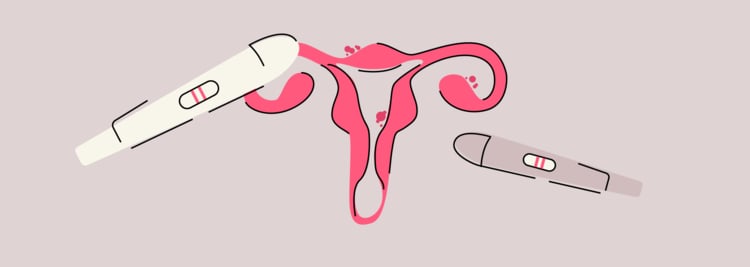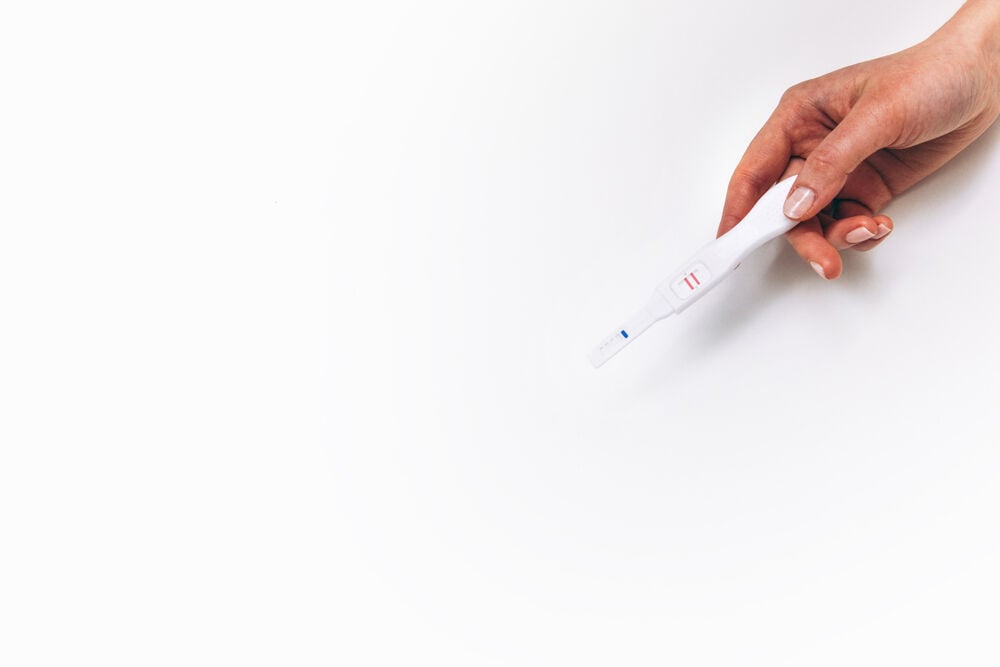People with endometriosis can become pregnant and carry a healthy pregnancy to term. Endometriosis is a complex disease that can cause pain and infertility, but there are treatment options, and pregnancy is possible. Read on to learn more about endometriosis and infertility, including how endometriosis causes infertility.
-
Tracking cycle
-
Getting pregnant
-
Pregnancy
-
Help Center
-
Flo for Partners
-
Anonymous Mode
-
Flo app reviews
-
Flo Premium New
-
Secret Chats New
-
Symptom Checker New
-
Your cycle
-
Health 360°
-
Getting pregnant
-
Pregnancy
-
Being a mom
-
LGBTQ+
-
Quizzes
-
Ovulation calculator
-
hCG calculator
-
Pregnancy test calculator
-
Menstrual cycle calculator
-
Period calculator
-
Implantation calculator
-
Pregnancy weeks to months calculator
-
Pregnancy due date calculator
-
IVF and FET due date calculator
-
Due date calculator by ultrasound
-
Medical Affairs
-
Science & Research
-
Pass It On Project New
-
Privacy Portal
-
Press Center
-
Flo Accuracy
-
Careers
-
Contact Us
How to Get Pregnant When You Have Endometriosis


Every piece of content at Flo Health adheres to the highest editorial standards for language, style, and medical accuracy. To learn what we do to deliver the best health and lifestyle insights to you, check out our content review principles.
How endometriosis affects fertility
Endometriosis is associated with infertility. The American Society for Reproductive Medicine states that endometriosis is found in 24 to 50 percent of women who are experiencing infertility. While it is not entirely clear how endometriosis affects fertility, there are some possible explanations. Women with endometriosis may have a harder time becoming pregnant.
Endometriosis is a very common, chronic gynecological condition that mostly affects women of reproductive age. It occurs when the endometrium (inner uterine lining) grows outside of the uterus. The most common places for this abnormal tissue to grow are the ovaries, fallopian tubes, pelvic peritoneum (lining of the pelvic cavity), uterine ligaments and its outer surface, bladder, intestines, and rectum.
In rare cases, endometriosis can also cause tissue to grow in other areas of the body. Even when they’re outside the uterus, endometriosis growths still respond to the hormonal changes of your menstrual cycle. They build up, thicken, and then break down, causing pain and swelling as the tissue has no way of leaving the body. This can lead to inflammation and scarring of the normal tissue surrounding the endometriosis growths. Adhesions (fibrous bands) can form between tissues and organs in the pelvis and abdominal cavity.
Although endometriosis growths are not cancerous, they can make it difficult to become pregnant. According to the American College of Obstetricians and Gynecologists, about 40 percent of women with infertility have endometriosis. Though the exact reason is not known, possible explanations include:
- Distorted anatomy of pelvic organs — In more moderate to severe cases of endometriosis, adhesions and scar tissue can make it hard for the ovary to release an egg or block the egg from reaching the fallopian tube to get fertilized by sperm.
- Endocrine and ovulatory abnormalities — According to the latest research, ovarian endometriosis can negatively affect ovulation and the number of mature eggs that can be fertilized. Elevated prolactin levels and luteinized unruptured follicle syndrome can also affect normal ovulation.
- Altered hormonal and cell-mediated functions in the endometrium — Inflammation from endometriosis can also create an inhospitable environment that affects the egg as well as sperm, making it hard for fertilization and implantation to be successful.
Chances of getting pregnant with endometriosis
Take a quiz
Find out what you can do with our Health Assistant

Although endometriosis and infertility are connected, most women with endometriosis are still able to get pregnant. Nearly 70 percent of women with mild to moderate endometriosis are able to become pregnant without treatment.
If you’re trying to get pregnant naturally, you might find it useful to track ovulation using an app like Flo. Knowing when you ovulate can improve your chances of getting pregnant by helping you time conception sex according to your fertile window.
For women with endometriosis who want to become pregnant (soon or in the distant future), most doctors recommend seeing a fertility specialist early on. Since it’s easier to become pregnant in your 20s than in your 30s or 40s, consider talking with your doctor about your options well in advance.
Nearly 70 percent of women with mild to moderate endometriosis are able to become pregnant without treatment.
If you’re in pain but not trying to get pregnant, your gynecologist can suggest non-hormonal or hormonal treatment options to manage the pain associated with endometriosis. Laparoscopic surgery is one of those options. Endometriosis surgery can make it possible for you to get pregnant. If you’re considering a laparoscopic surgery, it’s important to know that this surgery has the potential to reduce the quality and quantity of your viable eggs, especially if there are endometriomas.
Egg freezing is an option for women with endometriosis who might want to start a family in the future. The number of eggs you produce decreases over time, and endometriosis often gets progressively worse. Because of this, freezing your eggs can be a good option for increasing your chances of becoming pregnant in the future.
How to get pregnant when you have endometriosis
Getting pregnant when you have endometriosis may be difficult, but it is possible. Deciding how to proceed depends on timing and the severity of your endometriosis. Speaking with a fertility specialist is an important part of the process.
Before beginning any treatment, it’s important to have a full infertility work-up completed. This can help identify any other challenges or health issues, such as male fertility issues or age, that can further complicate the process of becoming pregnant.
An infertility work-up can also indicate the best treatment options for you. Before choosing the most appropriate treatment, you and your doctor will consider the severity of your symptoms, the stage of the disease, how long you’ve been trying to get pregnant, your age, and the possibility of assisted reproductive technologies (such as in-vitro fertilization). Your doctor will assess the quality and quantity of your viable eggs (known as your ovarian reserve), the condition of your fallopian tubes (tubal patency), sperm function, and your uterine cavity before starting any treatments. Treatment options become more limited as you get older, so it’s important to seek treatment early if you want to get pregnant later on.
A full infertility work-up can help identify any other challenges or health issues, such as male fertility issues or age, that can further complicate the process of becoming pregnant.
There are three main treatments for endometriosis-associated infertility. They are medical treatment, surgery, and assisted reproduction.
According to the latest guidelines from the European Society of Human Reproduction and Embryology, hormonal treatment to suppress ovarian function is not effective at improving fertility.
According to Cochrane Reviews, operative laparoscopy can increase the chances of becoming pregnant.
Some assisted reproduction options include the following:
- Superovulation and intrauterine insemination are two techniques that are often combined. Superovulation involves taking medication that can induce the production of more than one egg. Intrauterine insemination is the process of placing sperm directly in the uterus. This procedure can be done in conjunction with in-vitro fertilization (IVF) treatments or on its own.
- In-vitro fertilization (IVF) involves collecting your eggs and sperm, fertilizing the egg outside of your body, and then implanting the fertilized egg in the uterus. Pregnancy rates after IVF are lower in patients with moderate to severe endometriosis as compared with those with tubal factor infertility (when the fallopian tubes are blocked or damaged). If you are older than 35 and have been trying to get pregnant for a long time, direct IVF can be a good option.
It is also important to focus on your overall health. Women who exercise regularly; maintain a healthy weight; and eat plenty of whole foods including vegetables, fruits, and grains are better prepared to carry a healthy pregnancy to term. Women who are overweight, underweight, or malnourished have a much harder time becoming pregnant and supporting a healthy pregnancy.
Endometriosis and pregnancy
Now that you know it’s possible to get pregnant if you have endometriosis, what can you expect during your pregnancy? For some women with endometriosis, pregnancy can help stop painful symptoms and provide other relief.
You may find that being pregnant reduces your endometriosis symptoms, or you may notice little improvement. Each pregnancy is unique. For some, the increased levels of progesterone that circulate during pregnancy can bring relief. In fact, progestin, a synthetic form of progesterone, is often used as a treatment for endometriosis.
If symptoms improve during pregnancy, this relief may continue while you’re breastfeeding. However, once your periods return, whether you are breastfeeding or not, you are likely to experience a return of symptoms.
If you have endometriosis, being pregnant can increase possible complications. Because of inflammation, hormonal shifts, and damage to the uterus, pregnancy and delivery complications can include:
- Pregnancy loss — According to the latest studies, endometriosis is associated with a greater risk of miscarriage and ectopic pregnancy. While miscarriages cannot be prevented, it’s good to be familiar with the signs, which include bleeding, cramping, and low back pain at any time before 12 weeks into your pregnancy.
- Preterm birth — Women with endometriosis are 1.5 times more likely to deliver before 37 weeks of gestation. Some symptoms that indicate preterm labor include regular contractions, pelvic pressure, and changes to vaginal discharge.
- Placenta previa — This is when the placenta, which supplies nourishment to your growing baby, attaches to the bottom of the uterus instead of at the top or side. This can increase the risk of a ruptured placenta during labor, which can cause severe bleeding and pose an immediate danger for you and your baby. If you notice bright red vaginal bleeding, you should immediately contact your doctor.
- Endometriosis is also associated with a greater risk of gestational diabetes and hypertensive disorders of pregnancy.
If you’re struggling with pain from endometriosis during pregnancy, there are some at-home measures available. While over-the-counter pain relievers are not always recommended during pregnancy, you can try warm-water baths, prenatal yoga, and fiber-rich foods to reduce the risk of constipation.
Conclusion
While endometriosis can be a painful and complex disease, it’s still possible to become pregnant. Speaking with your doctor or an infertility specialist to discuss your options early on can help you choose the best plan for you.


Hey, I'm Anique
I started using Flo app to track my period and ovulation because we wanted to have a baby.


The Flo app helped me learn about my body and spot ovulation signs during our conception journey.


I vividly
remember the day
that we switched
Flo into
Pregnancy Mode — it was
such a special
moment.
Real stories, real results
Learn how the Flo app became an amazing cheerleader for us on our conception journey.




